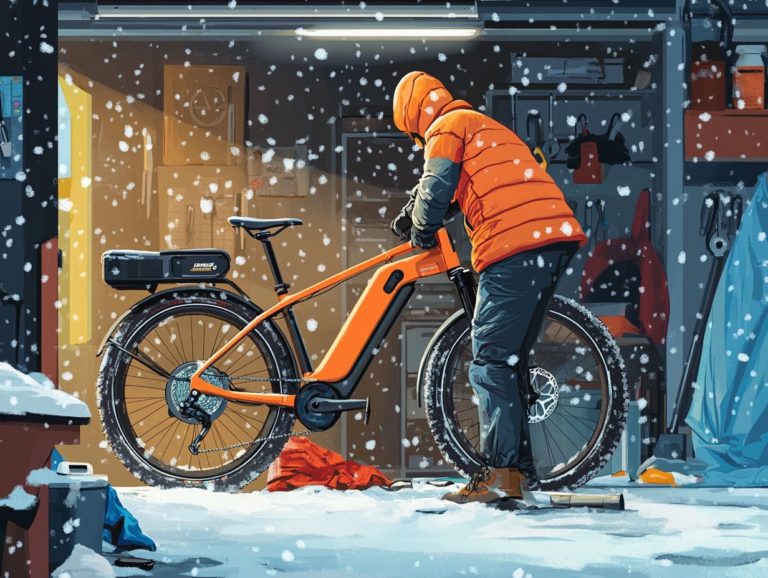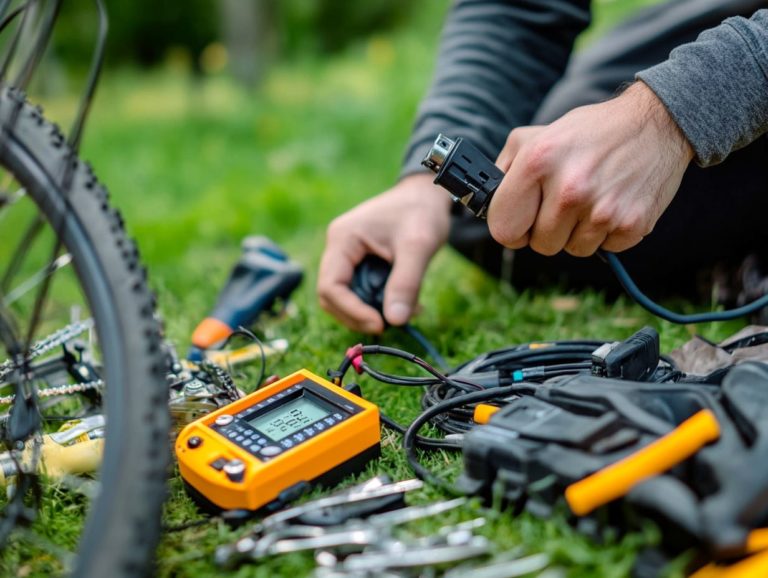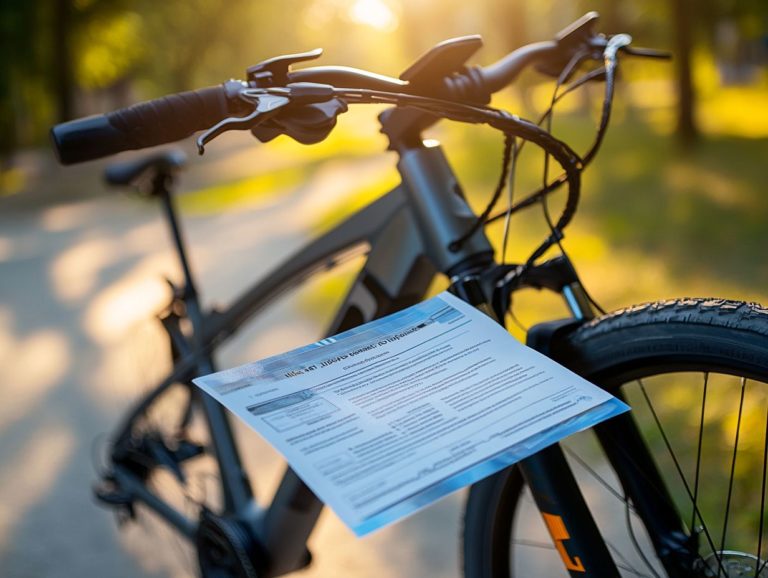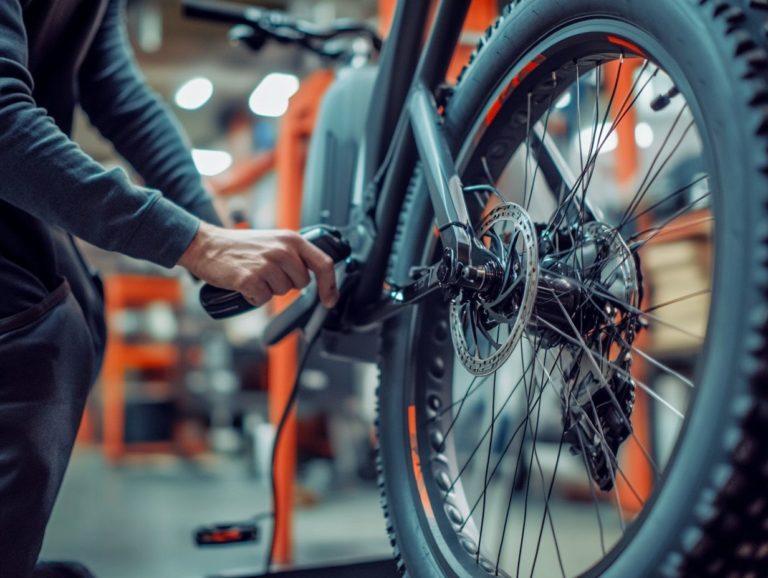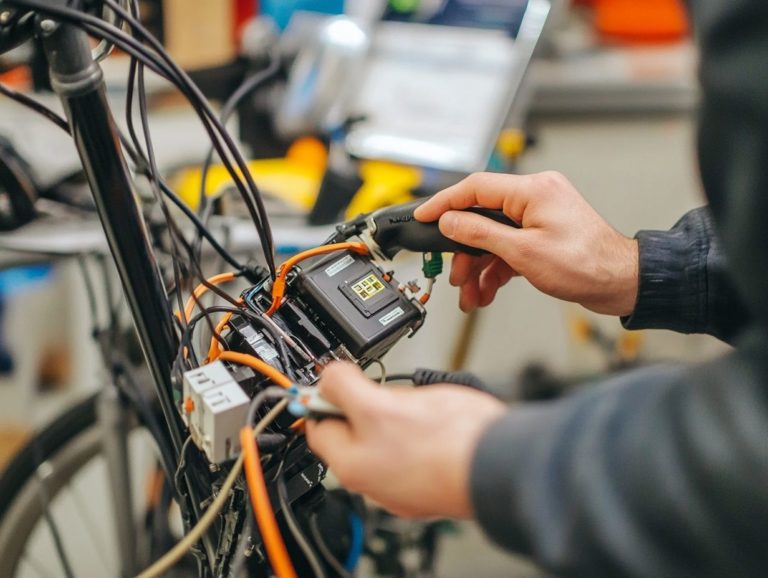Guide to Electric Bicycle Tire Maintenance
When it comes to electric bicycles, tire maintenance is crucial. With various tire types available, each designed for a specific purpose, knowing how to care for them can greatly enhance your riding experience.
This guide provides insights into the benefits of regular maintenance and troubleshooting common tire issues. You ll discover essential steps for inspecting, inflating, and replacing your tires, along with tips to make them last longer.
Ready to hit the road with confidence? Let s get started!
Contents
- Key Takeaways:
- Types of Tires and Their Functions
- Importance of Proper Tire Maintenance
- Steps for Maintaining Electric Bicycle Tires
- Troubleshooting Common Tire Issues
- Tips for Maximizing Tire Lifespan
- Frequently Asked Questions
- What is electric bicycle tire maintenance?
- Why is proper tire maintenance important for electric bicycles?
- How often should I check the tires on my electric bicycle?
- How do I check the tire pressure on my electric bicycle?
- What should I do if my electric bicycle tires are worn or damaged?
- Are there any special maintenance tips for electric bicycle tires?
Key Takeaways:
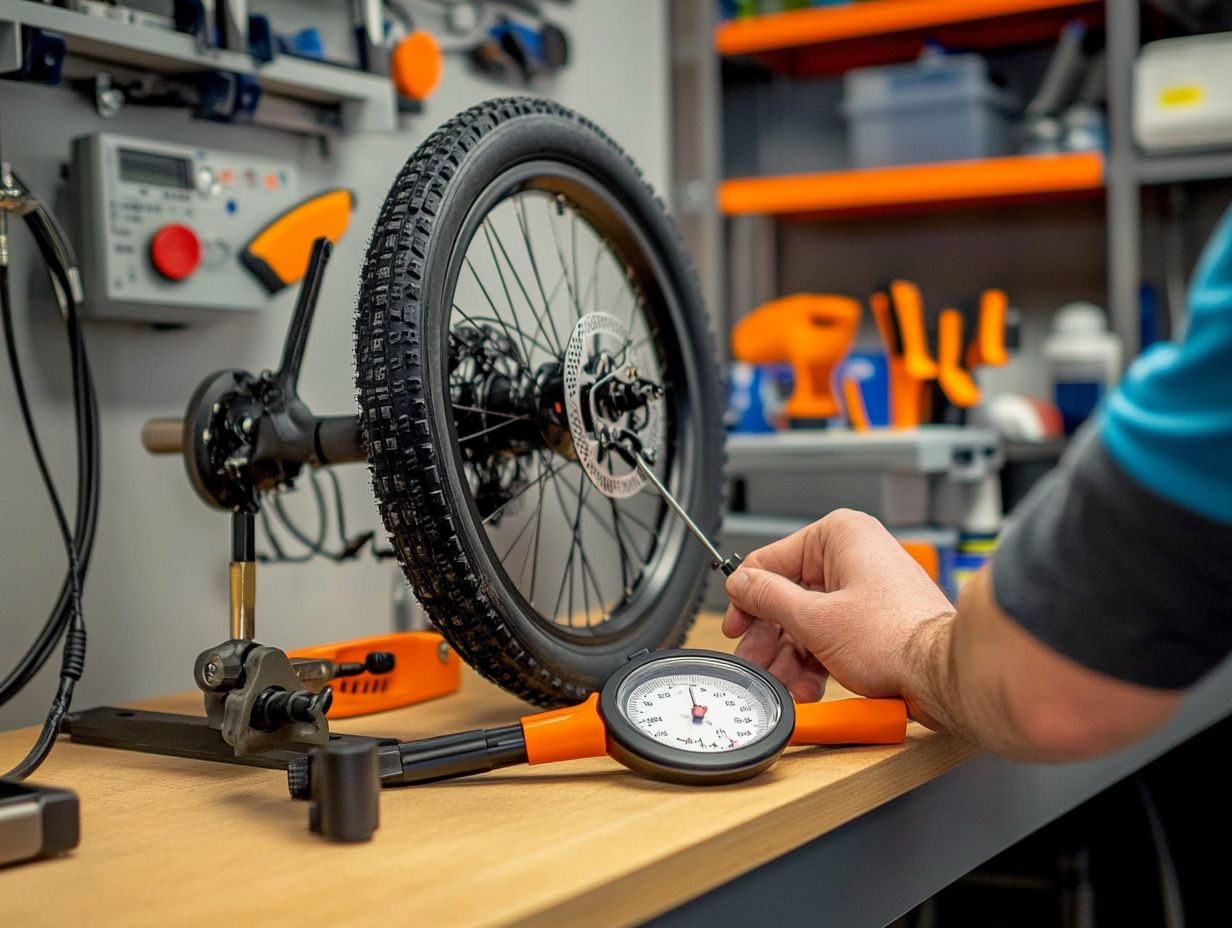
- Regular maintenance of electric bicycle tires is crucial for safety and optimal performance.
- Inspect tires for wear and tear, inflate them to the right pressure, and replace them when necessary to make them last longer.
- Choose the right tires and follow proper storage and cleaning techniques to maximize their lifespan.
Types of Tires and Their Functions
Understanding the various types of tires and their functions is essential for any bike owner looking to improve their riding efficiency and overall bike performance.
Different tires cater to diverse terrains and conditions, affecting grip, comfort, and durability. For example, mountain bike tires have knobby edges for exceptional traction on rugged trails, while road bike tires focus on low rolling resistance for a smooth ride on paved surfaces.
If you own an electric bicycle (e-bike), it’s essential to consider tires that are specifically engineered to handle the added weight and speed.
Importance of Proper Tire Maintenance
Proper tire maintenance is vital for maximizing your bike s performance and ensuring a safe riding experience. This is especially important for electric bicycles, where the extra weight can strain the tires. Regular inspections allow you to spot signs of wear and maintain optimal tire pressure, significantly enhancing handling and efficiency.
Neglecting tire maintenance can lead to flat tires or unsafe riding conditions, so prioritize tire care to keep your rides smooth and secure.
Benefits of Regular Maintenance
The benefits of regular bike maintenance extend beyond merely prolonging your bike’s lifespan; they also enhance both performance and safety. By checking vital components like tire pressure, brake wear, and drivetrain cleanliness, you ensure smoother rides and significantly reduce the risk of accidents.
This proactive approach improves your riding experience while also lowering potential repair costs over time. By addressing minor issues early, you can prevent more extensive damage that tends to be costly and time-consuming to fix. A well-maintained bike operates optimally across various conditions, offering improved handling and efficiency whether you’re on the road or the trail.
Ultimately, these practices instill greater confidence in your bike s reliability, paving the way for a more enjoyable and worry-free riding adventure.
Steps for Maintaining Electric Bicycle Tires
Maintaining the tires on your electric bicycle is critical for safety, performance, and longevity. Start by gathering the right tools for tire inspection and maintenance.
Regularly check the tire pressure, as e-bikes can put extra stress on tires compared to traditional bicycles. Next, conduct a thorough visual inspection of the tires for any signs of wear and tear, ensuring they remain in peak condition for your rides.
Check your tires today for a safer ride!
Inspecting Tires for Wear and Tear
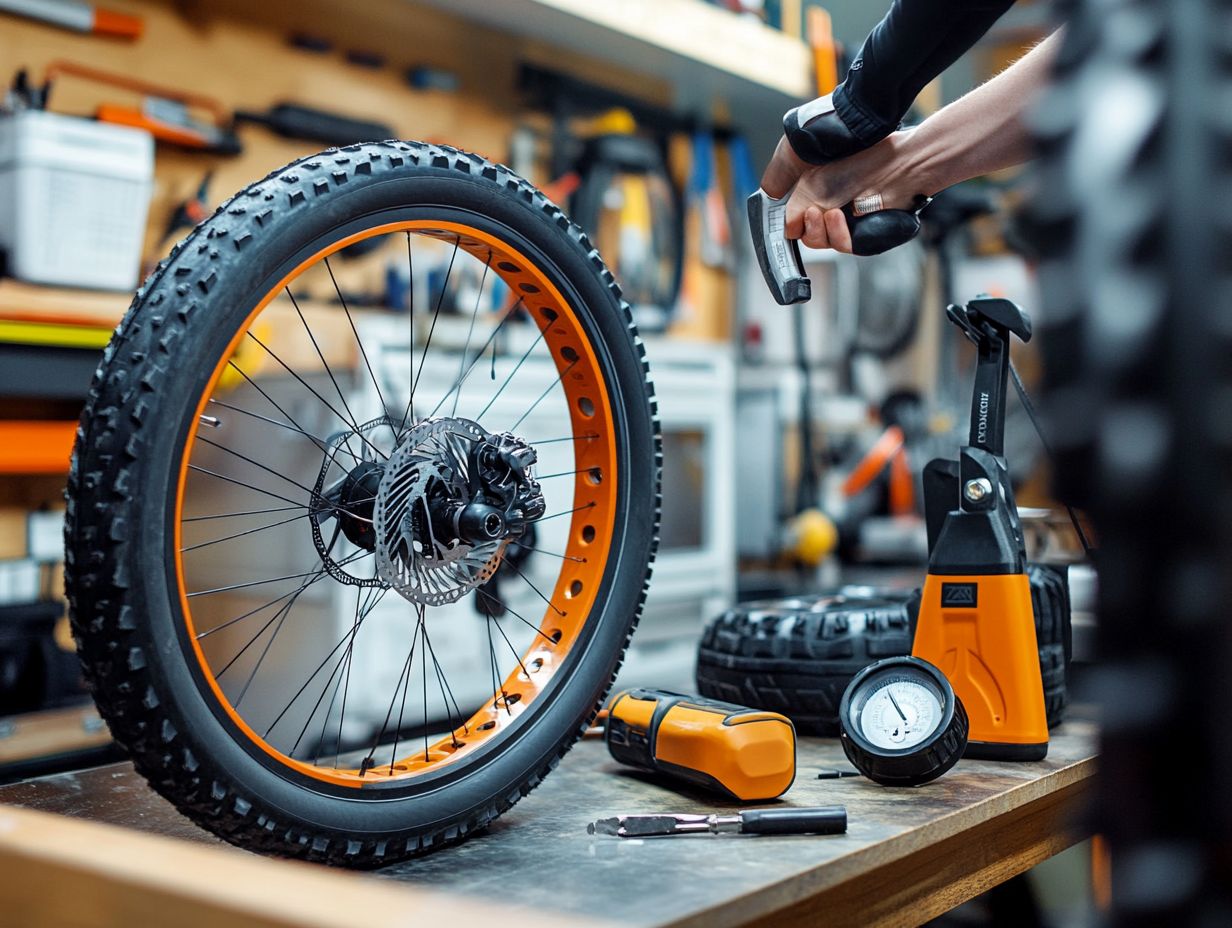
Inspecting your tires for wear and tear is crucial for bike maintenance and can significantly impact your safety and riding experience. Regularly checking for signs of wear, such as cracks, bulges, and uneven tread, helps prevent accidents and improves your bicycle’s overall performance.
This proactive approach ensures a smoother ride and extends the lifespan of your tires.
To assess your tires’ condition effectively, start with a thorough visual inspection. Look for any irregularities that signal upcoming issues. Use the penny test to gauge tread depth by inserting a coin into the grooves; if the head is barely visible, you re in good shape.
Don t ignore these wear signs they can threaten your safety and grip! Neglecting them may lead to compromised traction, longer stopping distances, and an increased risk of blowouts, putting both your safety and your bike s longevity at risk.
For this reason, regular inspections should be a fundamental part of your cycling routine. This habit helps you maintain optimum performance and reduces hazards on the road.
Inflating Tires to Optimal Pressure
Inflating your bike tires to the optimal pressure is essential for achieving peak performance and ensuring your safety on the road. Proper tire inflation enhances grip, improves fuel efficiency on electric bicycles, and minimizes the risk of flats.
Keep a reliable pressure gauge handy to regularly check and adjust your tire pressure according to the manufacturer’s specifications. This practice promotes a smoother ride and contributes significantly to your bike’s overall care. Additionally, knowing how to fix a flat tire on your electric bicycle can be invaluable for maintaining your ride.
Different types of bicycles require distinct pressure levels for optimal performance. For example, road bikes typically need a higher pounds per square inch (psi), while mountain bikes thrive on lower pressures to better absorb shocks on rugged terrains. Maintaining these specific levels leads to improved handling and reduced rolling resistance, resulting in faster speeds and greater comfort on longer rides.
Regularly checking your tire pressure is particularly important, as fluctuations can occur due to temperature changes or the wear and tear of regular use. This straightforward practice not only ensures your safety but can also extend the life of your tires, ultimately saving you money on replacements.
Replacing Tires when Necessary
Replacing tires when necessary is vital for bike maintenance and profoundly influences both safety and performance.
Regularly inspect your tires for signs of wear that could jeopardize your ride. Look out for uneven tread wear, which may indicate misalignment or improper inflation.
Watch for weather-related deterioration, like dry rot from too much sun exposure. Riding on tires that have seen better days not only heightens the risk of accidents but can also result in expensive repairs and a less enjoyable riding experience.
By understanding these key criteria, you ll be better equipped to maintain your bike and enjoy safer, smoother rides for years to come.
Troubleshooting Common Tire Issues
Troubleshooting common tire issues is an invaluable skill for any bike owner, ensuring a seamless ride and minimizing the risk of unexpected breakdowns. Whether you’re dealing with flat tires from pesky punctures or noticing uneven wear patterns, being able to diagnose and address these challenges can greatly enhance your biking experience.
Keep a patch kit and essential bike tools within reach to transform potential headaches into manageable tasks. This preparation allows you to focus on the joy of the ride rather than the stress of repairs.
Check your tire pressure before your next ride to ensure peak performance!
Dealing with Punctures and Flats
Dealing with punctures and flat tires is a normal part of owning a bike, and having the right tools, like a patch kit, transforms what could be a frustrating ordeal into a quick and efficient repair. By understanding common culprits of punctures such as sharp objects or improper inflation you can take proactive measures to prevent these issues from arising. Regularly checking your tires allows you to catch potential problems early, enabling you to address them before they escalate into full-blown flats.
Plus, keeping a patch kit within reach is wise. It’s also a good idea to invest in a quality tire lever and a hand pump for those on-the-go repairs. When it comes time to fix a puncture, start by removing the wheel and tire from your bike frame. For maintaining your bike’s durability, refer to a guide to electric bicycle frame maintenance. Inspect the inner tube for any visible damage and mark the puncture area.
Clean the surface, apply the patch according to the instructions, and hold it firmly in place for a few moments to ensure a solid seal. Once you ve reassembled your tire and wheel, double-check that it s snug before you reinflate. To minimize the risk of future flats, consider investing in tires that resist flat tires and steering clear of debris or rough terrain when you can. Maintaining proper tire pressure the amount of air in your tires also plays a crucial role in reducing the likelihood of flats, ultimately extending the life of your tires.
Addressing Uneven Wear on Tires
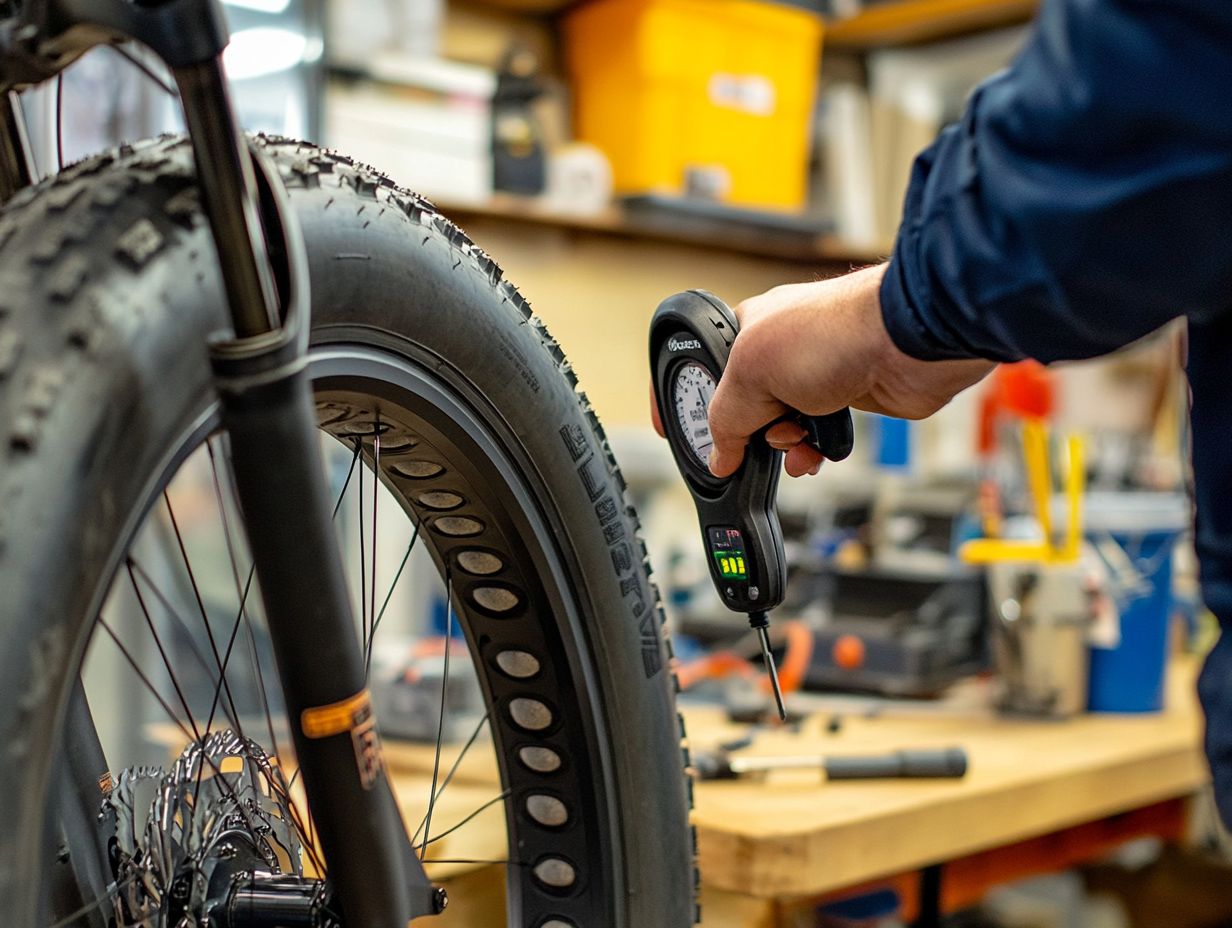
Addressing uneven tire wear is essential for maintaining best bike performance and ensuring your safety on the road. When your tires wear unevenly, it can signal various issues such as misalignment or improper inflation, which in turn can compromise handling and efficiency. By routinely inspecting your tires, you can identify these wear patterns and take corrective actions that will enhance your riding experience.
Improper tire pressure is a frequent culprit behind uneven wear. Whether it’s overinflation or underinflation, both can cause specific areas of your tire to wear out faster than others. Frequent changes in terrain can worsen uneven wear, especially if your bike isn’t designed for varying surfaces.
Regular tire rotations and alignments are crucial practices that can help mitigate these issues and promote even wear. Alongside these practices, checking cables regularly contributes to overall safety and performance. Always maintain your bike, including the brake and suspension systems, as this will contribute to prolonging tire life and improving performance. Additionally, inspecting brake pads regularly can prevent brake wear and enhance safety. For a comprehensive approach, refer to the electric bicycle maintenance checklist for owners.
Tips for Maximizing Tire Lifespan
Maximize your bike tires’ lifespan with careful maintenance and storage. It’s essential to embrace a blend of meticulous care, effective maintenance practices, and strategic storage techniques. By maintaining optimal tire pressure, tire inflation, regularly cleaning the tires, and storing them in a climate-controlled environment, you can significantly extend their longevity.
Moreover, staying vigilant about the condition of your tires allows for timely interventions and replacements, ultimately ensuring a safe and enjoyable riding experience. This includes checking for wear signs and any necessary tire replacement.
Proper Storage and Cleaning Techniques
Proper storage and cleaning techniques are essential elements of tire care that can greatly influence their longevity and performance. By regularly cleaning your tires to remove dirt and debris, you not only enhance their appearance but also prevent unnecessary wear and tear. Storing your bike in a cool, dry location away from direct sunlight ensures that the rubber compounds in the tires remain intact and effective.
For optimal results, it’s advisable to use mild soaps specifically formulated for tire cleaning, along with brushes that have soft bristles to avoid scratching. Steering clear of harsh chemicals is crucial for maintaining the integrity of the rubber.
Regarding storage, consider utilizing tire covers or placing your bike on a stand to protect the tires from unnecessary pressure and deformation. Additionally, keeping your tires inflated to the correct pressure will not only boost overall performance but also extend their lifespan, allowing for a smoother ride when you’re ready to hit the road.
Act now to prevent costly repairs!
Choosing the Right Tires for Your Electric Bicycle
Choosing the right tires for your electric bicycle is essential for enhancing your riding efficiency and ensuring your safety.
You need to consider factors like tire type, tread pattern, and size, all of which should match your bike’s intended use whether that’s commuting, off-road adventures, or riding through city streets. Understanding the specific demands of electric bicycles (e-bikes) is crucial for longevity, and learning how to maintain your electric bicycle, such as their added weight and speed, will help you select the most suitable tires.
Choosing tires that provide the right grip is crucial. For instance, knobby tires are perfect for rugged trails, while slick tires excel on paved roads. Reflecting on your personal riding style is equally important whether you prioritize comfort for long-distance rides or seek agility for quick urban maneuvers.
The right tire choice can significantly impact your performance and safety! It ensures better traction and control, ultimately elevating your overall riding experience and contributing to regular electric bike maintenance.
Frequently Asked Questions
What is electric bicycle tire maintenance?
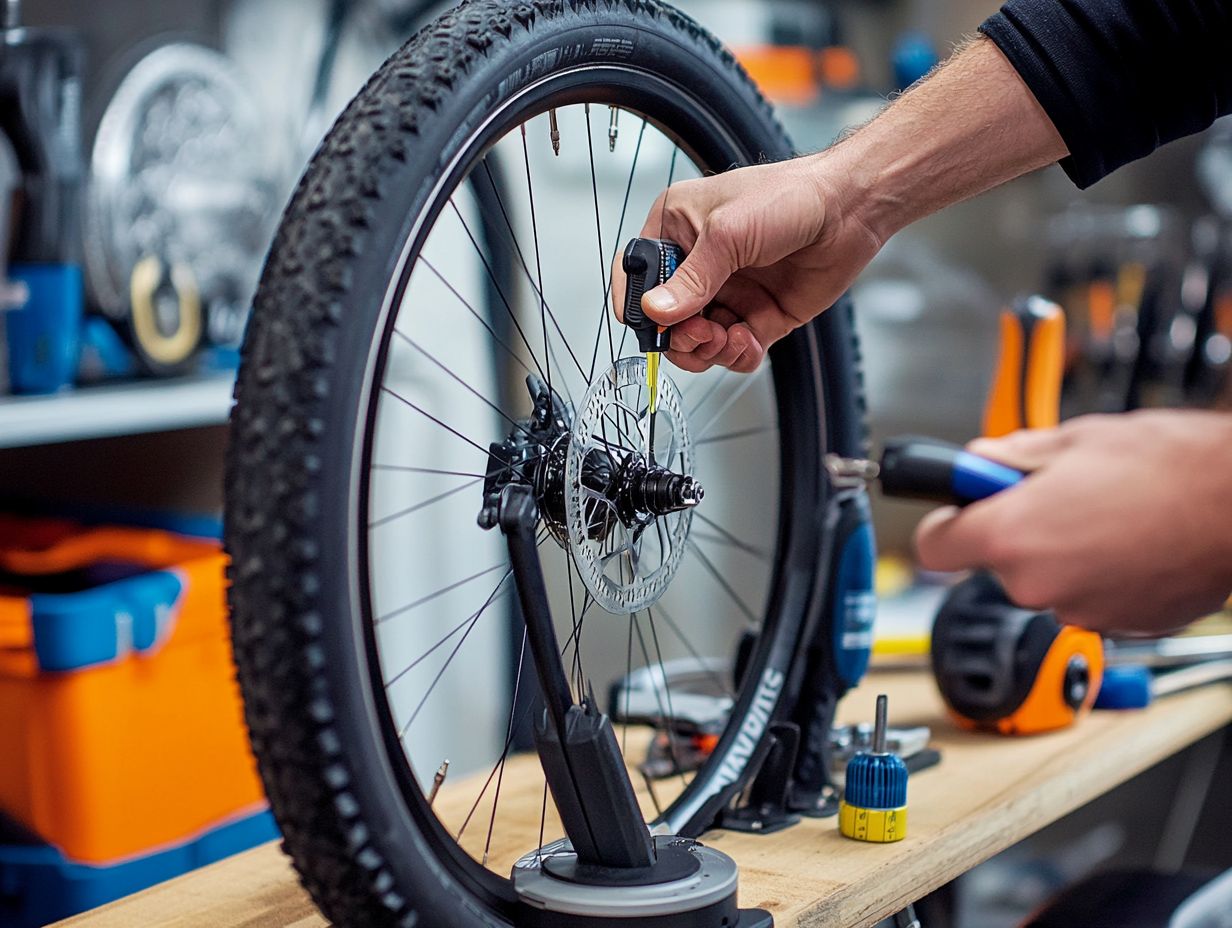
Electric bicycle tire maintenance refers to the regular upkeep and care of the tires on an electric bicycle, including checking for wear and tear, maintaining proper tire pressure, and making any necessary repairs or replacements.
Why is proper tire maintenance important for electric bicycles?
Proper tire maintenance is important for electric bicycles because it ensures safe and efficient performance. Well-maintained tires provide better traction, reduce the risk of accidents, and can extend the lifespan of the electric bicycle.
How often should I check the tires on my electric bicycle?
It is recommended to check the tires on your electric bicycle at least once a week. However, if you ride your electric bicycle frequently or on rough terrain, it is a good idea to check the tires more often.
How do I check the tire pressure on my electric bicycle?
To check the tire pressure on your electric bicycle, use a tire pressure gauge to measure the PSI (pounds per square inch) of each tire. Compare the measurement to the recommended PSI listed on the tire or in the electric bicycle’s manual.
What should I do if my electric bicycle tires are worn or damaged?
If your electric bicycle tires are worn or damaged, it is important to replace them as soon as possible. Riding on worn or damaged tires can be dangerous and may lead to accidents. Consult a professional for proper tire replacement.
Are there any special maintenance tips for electric bicycle tires?
Yes, there are a few special maintenance tips for electric bicycle tires. It is recommended to use puncture-resistant tires for added protection, avoid over-inflating the tires, and to regularly clean and inspect the tires for debris or damage.
Don’t compromise your ride choose the best tires! Regularly check your bicycle tires to maintain safety and performance.


